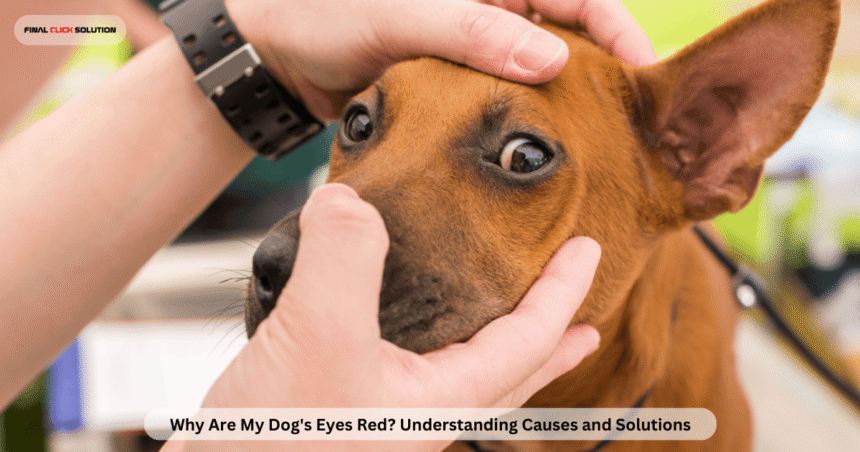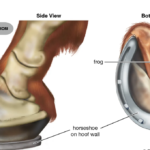When you notice that your dog’s eyes are red, it can be concerning. A dog’s eyes are typically bright and clear, so any change, such as redness, may signal an underlying issue. Red eyes in dogs can stem from various causes, ranging from minor irritations to serious health conditions. In this article, we’ll explore the reasons why my dog’s eye is red, what you can do about it, and when to seek veterinary care. By understanding the potential causes of dog red eyes, you can take steps to ensure your furry friend stays healthy and comfortable.
Common Causes of Red Eyes in Dogs
1. Allergies
One of the most common reasons why is my dog’s eye red is allergies. Just like humans, dogs can suffer from environmental allergies triggered by pollen, dust, mold, or certain foods. These allergens can irritate the eyes, leading to redness, itching, and watery discharge. Seasonal allergies are particularly common in spring and fall when pollen counts are high. If your dog is rubbing their eyes or face frequently, allergies might be the culprit.
Symptoms of allergies include:
- Red, watery eyes
- Itchy skin or ears
- Sneezing or coughing
Action: Identify potential allergens by observing when symptoms occur. For example, if dogs eyes red appear during walks in grassy areas, pollen could be the trigger. Over-the-counter antihistamines may help, but consult your vet before administering any medication. Keeping your dog’s living area clean and using air purifiers can reduce allergen exposure.
2. Conjunctivitis
Conjunctivitis, or pink eye, is another reason why is my dog’s eyes red. This condition involves inflammation of the conjunctiva, the thin membrane covering the white part of the eye and the inner eyelids. Conjunctivitis can be caused by infections (bacterial or viral), allergies, or irritants like dust or smoke. It’s highly contagious between dogs, so if you have multiple pets, isolate the affected dog.
Symptoms include:
- Redness in one or both eyes
- Thick, yellow, or green discharge
- Squinting or blinking excessively
Action: Veterinary treatment is essential for conjunctivitis. Your vet may prescribe antibiotic or anti-inflammatory eye drops. Avoid using human eye drops, as they can be harmful to dogs. Keep the eye area clean by gently wiping away discharge with a damp cloth.
3. Dry Eye (Keratoconjunctivitis Sicca)
Why my dog eye is red could be due to a condition called keratoconjunctivitis sicca (KCS), or dry eye. This occurs when the tear glands produce insufficient tears to keep the eyes lubricated. Without proper moisture, the eyes become irritated, red, and prone to infections. Dry eye is common in breeds like Shih Tzus, Bulldogs, and Cocker Spaniels.
Symptoms include:
- Persistent redness
- Thick, sticky discharge
- Frequent blinking or squinting
Action: A veterinarian can diagnose dry eye with a tear production test. Treatment typically involves artificial tear solutions or medications like cyclosporine to stimulate tear production. Untreated dry eye can lead to corneal ulcers, so prompt care is crucial.
4. Corneal Ulcers
A corneal ulcer is a scratch or injury on the cornea, the clear surface of the eye, and it’s a common reason why is my dogs eye red. Ulcers can result from trauma (e.g., a scratch from a branch), foreign objects, or even excessive rubbing due to allergies. Breeds with prominent eyes, like Pugs or Pekingese, are more prone to corneal injuries.
Symptoms include:
- Intense redness
- Sensitivity to light
- Pawing at the eye
Action: Corneal ulcers require immediate veterinary attention. Your vet may use a fluorescein stain to diagnose the ulcer and prescribe antibiotic drops or surgery in severe cases. A protective cone may be necessary to prevent further damage.
5. Glaucoma
Glaucoma is a serious condition that can explain dogs eye is red. It occurs when fluid builds up in the eye, increasing pressure and causing pain and redness. If left untreated, glaucoma can lead to vision loss or blindness. Breeds like Beagles, Cocker Spaniels, and Basset Hounds are genetically predisposed.
Symptoms include:
- Red, cloudy eyes
- Dilated pupils
- Severe pain (e.g., head pressing or hiding)
Action: Glaucoma is an emergency. If you suspect it, take your dog to the vet immediately. Treatment may include medications to reduce eye pressure or, in severe cases, surgery. Early intervention can save your dog’s vision.
6. Foreign Objects or Irritants
Sometimes, dog red eyes are caused by something as simple as a foreign object, like dust, grass, or an eyelash, getting stuck in the eye. Irritants like smoke, shampoo, or chemicals can also cause redness. These issues are usually temporary but can lead to infections if not addressed.
Symptoms include:
- Redness in one eye
- Excessive tearing
- Rubbing or pawing at the eye
Action: Gently flush the eye with saline solution or clean water to remove the irritant. If redness persists or worsens, consult a vet to rule out scratches or infections.
7. Uveitis
Uveitis, inflammation of the uvea (the middle layer of the eye), is another potential cause of red eyes. It can result from infections, trauma, autoimmune diseases, or underlying conditions like cancer. Uveitis is painful and can lead to complications like glaucoma or cataracts if untreated.
Symptoms include:
- Redness around the iris
- Sensitivity to light
- Cloudy appearance in the eye
Action: Uveitis requires veterinary diagnosis through a thorough eye exam. Treatment may involve anti-inflammatory medications or steroids. Addressing the underlying cause is critical to prevent recurrence.
8. Infections
Bacterial, viral, or fungal infections can cause why is my dog’s eyes red. For example, canine distemper or Lyme disease can lead to eye inflammation. Infections often accompany other symptoms like fever, lethargy, or nasal discharge.
Symptoms include:
- Red, swollen eyes
- Thick discharge
- General illness or lethargy
Action: Veterinary care is necessary to identify the infection’s cause. Your vet may prescribe antibiotics, antivirals, or antifungal medications based on the diagnosis.
9. Breed-Specific Issues
Certain breeds are more prone to dogs eyes red due to their anatomy. Brachycephalic breeds (e.g., Pugs, Bulldogs) have shallow eye sockets, making their eyes more exposed to irritation. Breeds with long facial hair, like Yorkshire Terriers, may experience redness from hair rubbing against the eyes.
Action: Regular grooming and cleaning around the eyes can prevent irritation in these breeds. If redness persists, a vet can recommend protective measures or treatments.
10. Systemic Health Problems
In some cases, red eyes are a symptom of a broader health issue, such as autoimmune disorders, diabetes, or high blood pressure. These conditions can affect blood vessels in the eyes, causing redness or hemorrhages.
Symptoms include:
- Redness in both eyes
- Changes in behavior or appetite
- Weight loss or lethargy
Action: A comprehensive veterinary exam, including blood tests, can identify systemic issues. Treating the underlying condition will often resolve the eye redness.
When to See a Veterinarian
If you’re wondering why is my dogs eye red and notice any of the following, contact your vet immediately:
- Persistent or worsening redness
- Thick or colored discharge
- Squinting, pawing, or signs of pain
- Cloudiness or changes in pupil size
- Behavioral changes, like lethargy or aggression
Prompt veterinary care can prevent complications and preserve your dog’s vision. Even if the redness seems minor, it’s better to err on the side of caution.
Home Care Tips for Mild Cases
For mild cases of dog red eyes, such as those caused by minor irritants or allergies, you can try the following at home:
- Clean the eyes: Use a vet-approved saline solution or warm water to gently clean around the eyes. Use a clean cloth or cotton pad for each eye to avoid spreading infection.
- Prevent scratching: Use a cone or Elizabethan collar to stop your dog from rubbing their eyes, which can worsen irritation.
- Monitor symptoms: Keep a log of when redness occurs, any accompanying symptoms, and potential triggers (e.g., new foods or environments).
- Avoid human medications: Never use human eye drops or ointments unless prescribed by a vet.
However, home care should not replace professional veterinary advice, especially if symptoms persist beyond a day or two.
Preventing Red Eyes in Dogs
Preventing why my dog eye is red involves proactive care:
- Regular grooming: Trim hair around the eyes to prevent irritation, especially in long-haired breeds.
- Clean environment: Keep your dog’s bedding and living area free of dust and allergens.
- Routine vet checkups: Regular eye exams can catch issues early, especially in breeds prone to eye problems.
- Protective gear: Consider dog goggles for outdoor activities in dusty or windy conditions.
Conclusion
Red eyes in dogs can have many causes, from simple irritations to serious conditions like glaucoma or infections. By understanding why are my dog’s eyes red, you can take swift action to address the issue. Whether it’s allergies, conjunctivitis, or a foreign object, early intervention is key to keeping your dog healthy. Always consult a veterinarian if you’re unsure about the cause or if symptoms worsen. With proper care and attention, you can help your dog maintain bright, healthy eyes and a happy life.








